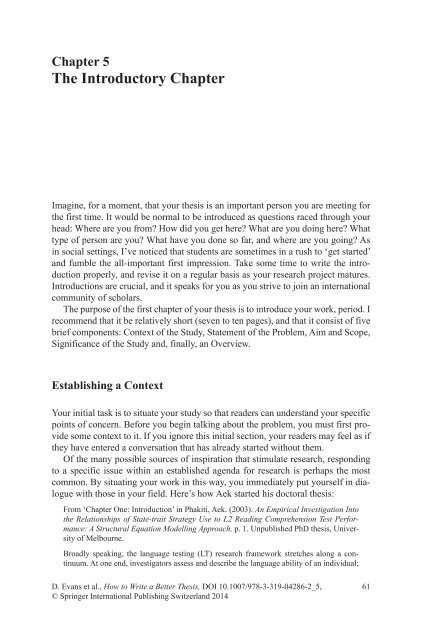How-to-Write-a-Better-Thesis
Create successful ePaper yourself
Turn your PDF publications into a flip-book with our unique Google optimized e-Paper software.
Chapter 5<br />
The Introduc<strong>to</strong>ry Chapter<br />
Imagine, for a moment, that your thesis is an important person you are meeting for<br />
the first time. It would be normal <strong>to</strong> be introduced as questions raced through your<br />
head: Where are you from? <strong>How</strong> did you get here? What are you doing here? What<br />
type of person are you? What have you done so far, and where are you going? As<br />
in social settings, I’ve noticed that students are sometimes in a rush <strong>to</strong> ‘get started’<br />
and fumble the all-important first impression. Take some time <strong>to</strong> write the introduction<br />
properly, and revise it on a regular basis as your research project matures.<br />
Introductions are crucial, and it speaks for you as you strive <strong>to</strong> join an international<br />
community of scholars.<br />
The purpose of the first chapter of your thesis is <strong>to</strong> introduce your work, period. I<br />
recommend that it be relatively short (seven <strong>to</strong> ten pages), and that it consist of five<br />
brief components: Context of the Study, Statement of the Problem, Aim and Scope,<br />
Significance of the Study and, finally, an Overview.<br />
Establishing a Context<br />
Your initial task is <strong>to</strong> situate your study so that readers can understand your specific<br />
points of concern. Before you begin talking about the problem, you must first provide<br />
some context <strong>to</strong> it. If you ignore this initial section, your readers may feel as if<br />
they have entered a conversation that has already started without them.<br />
Of the many possible sources of inspiration that stimulate research, responding<br />
<strong>to</strong> a specific issue within an established agenda for research is perhaps the most<br />
common. By situating your work in this way, you immediately put yourself in dialogue<br />
with those in your field. Here’s how Aek started his doc<strong>to</strong>ral thesis:<br />
From ‘Chapter One: Introduction’ in Phakiti, Aek. (2003). An Empirical Investigation In<strong>to</strong><br />
the Relationships of State-trait Strategy Use <strong>to</strong> L2 Reading Comprehension Test Performance:<br />
A Structural Equation Modelling Approach, p. 1. Unpublished PhD thesis, University<br />
of Melbourne.<br />
Broadly speaking, the language testing (LT) research framework stretches along a continuum.<br />
At one end, investiga<strong>to</strong>rs assess and describe the language ability of an individual;<br />
D. Evans et al., <strong>How</strong> <strong>to</strong> <strong>Write</strong> a <strong>Better</strong> <strong>Thesis</strong>, DOI 10.1007/978-3-319-04286-2_5,<br />
© Springer International Publishing Switzerland 2014<br />
61














![[Lonely Planet] Sri Lanka](https://img.yumpu.com/59845622/1/169x260/lonely-planet-sri-lanka.jpg?quality=85)


